
Longburn railway station was a station in Longburn, on the North Island Main Trunk in New Zealand. The platform, which is across from the Fonterra Factory, remains but the structure has been demolished.

Te Kumi railway station was a station on the North Island Main Trunk in New Zealand. The railway had been delayed by Māori opposition to it entering King Country and Te Kumi was one of the last places where such resistance was shown.

Ōhaupō railway station was a station located at Ōhaupō on the North Island Main Trunk in New Zealand. It was the terminus of the line from Auckland from 1878 to 1880 and closed in 1982. Only a passing loop remains.

Taumarunui railway station is the main railway station in Taumarunui, New Zealand, serving the Northern Explorer service between Auckland and Wellington. Historically, it was an important intermediate stop with a refreshment room on the North Island Main Trunk line; the subject of the ballad "Taumarunui on the Main Trunk Line" by Peter Cape.

Otorohanga railway station serves the town of Ōtorohanga, on the North Island Main Trunk in New Zealand. The current station dates from 1924.

Te Kuiti railway station is a station on the North Island Main Trunk in New Zealand. The station was important in the growth of Te Kūiti.

Waiteti was a passing loop on the North Island Main Trunk railway (NIMT) in New Zealand, built in 1939 to relieve congestion along a single track block, where the line rises steeply from Te Kuiti on a 1 in 70 gradient for 7 mi (11 km), including curves of 8 ch (160 m) to 20 ch (400 m) radius. It was 470.07 km (292.09 mi) from Wellington. From its opening it was under central control from Te Kuiti signalbox. The loop could hold 100 4-wheeled wagons.
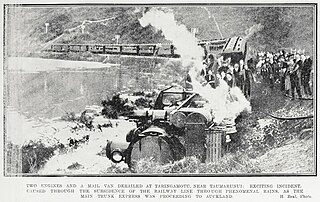
Taringamotu railway station was a station at Taringamotu on the North Island Main Trunk, in the Ruapehu District and Manawatū-Whanganui region.

Okahukura railway station was a station on the North Island Main Trunk in New Zealand.

Poro-O-Tarao was a flag station on the North Island Main Trunk line, in the Waitomo District of New Zealand. Between the watersheds of the upper Mōkau and Whanganui rivers, the NIMT enters Poro-O-Tarao tunnel under Tihikārearea hill, before descending the Ōngarue valley. It was 9.68 km (6.01 mi) north of Waimiha and 5.89 km (3.66 mi) south of Mangapehi.

Mangapehi was a flag station on the North Island Main Trunk line, in the Waitomo District of New Zealand. It was 5.89 km (3.66 mi) north of Poro-O-Tarao and 5.15 km (3.20 mi) south of Kopaki.
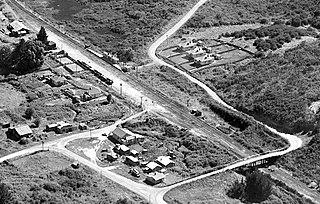
Kopaki was a flag station on the North Island Main Trunk line, in the Waitomo District of New Zealand.
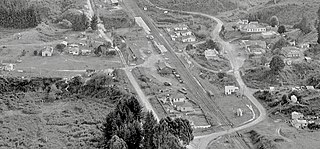
Waimiha was a flag station on the North Island Main Trunk line, in the Ruapehu District of New Zealand, serving the small village of Waimiha in the Ōngarue valley. Its site covered 6 acres (2.4 ha), with a shelter shed, platform, cart approach and loading bank. A goods shed was added about 1910. A passing loop could hold 42 wagons, extended to 80 wagons by 1980. The passing loop is still in use.

Piriaka was a station on the North Island Main Trunk line, in the Ruapehu District of New Zealand, serving Piriaka. It was 5.27 km (3.27 mi) north of Kakahi and 4.63 km (2.88 mi) south of Manunui. It formally opened on 9 November 1908, though it was renamed from Pirihaka on 25 April 1902 and work was well advanced by 1903, with the rails laid south of Piriaka by May 1904. Goods traffic started on 11 October 1904. By 10 November 1908 a passing loop could take 48 wagons and there was a 6th class station, with water supply, privies and urinals, a 300 ft (91 m) x 20 ft (6.1 m) passenger platform, loading bank, cattle yards and a 30 ft (9.1 m) x 20 ft (6.1 m) goods shed.

Kakahi was a station on the North Island Main Trunk line, in the Ruapehu District of New Zealand, serving Kakahi. It formally opened on 9 November 1908. The rails were laid south of Piriaka by May 1904 and a daily ballast train was running by October, which also carried passengers. Kakahi Bridge has five spans of 44 ft (13 m) and one of 23 ft (7.0 m) supplied by G. Fraser & Sons of Auckland, which delayed construction to the south. It crosses the Kakahi Stream, which was sometimes called the Waitea River.

Ōwhango was a station on the North Island Main Trunk line, in the Ruapehu District of New Zealand. It served the village of Ōwhango, which lay to the north of the station. It was 5.64 km (3.50 mi) north of Oio and 9.11 km (5.66 mi) south of Kakahi. The Public Works Department transferred the station to NZ Railways on 9 November 1908, though bush had been felled along the railway route in 1904, by March 1905 a station yard was being formed and by August 1905 it was the railhead, with track laid 4 mi (6.4 km) beyond to the south.
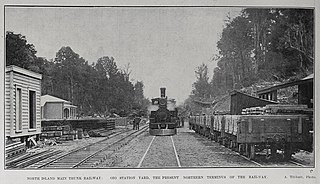
Oio was a station on the North Island Main Trunk line, in the Ruapehu District of New Zealand. It served the hamlet of Oio, which lay to the north of the station. It was 8.29 km (5.15 mi) north of Raurimu and 5.64 km (3.50 mi) south of Ōwhango. It was one of the many temporary railheads along the route, with work going on from 1904 to 1908.

Mataroa was a station on the North Island Main Trunk line, in the Ruapehu District of New Zealand. It served the village of Mataroa. Mataroa is part way up a long gradient from Taihape to Waiouru, beginning at 1 in 60, but largely 1 in 70 from Mataroa to Hīhītahi, so that Mataroa is 88 m (289 ft) above Taihape and 110 m (360 ft) below Ngaurukehu.

Tangiwai was a station on the North Island Main Trunk line, in the Ruapehu District of New Zealand. The station served the settlement of Tangiwai. The nearby pulp and saw mills are now one of the main sources of freight on NIMT. In 1953 the Tangiwai disaster occurred when the nearby bridge over the Whangaehu River was swept away.
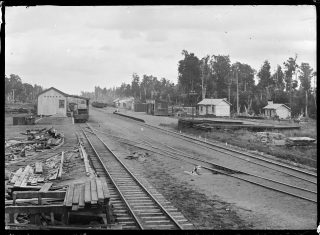
Pokaka was a station on the North Island Main Trunk line, in the Ruapehu District of New Zealand. It served the small village of Pokaka and lay to the south of Makatote Viaduct, the late completion of which held up opening of the station.























